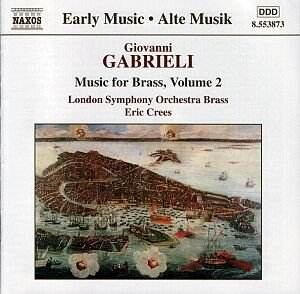Giovanni GABRIELI (c1553 - 1612)
Music for Brass, Volume 2
-
Canzon à 12 [3.30]
-
Canzon V [2.51]
-
Sonata XVIII [6.21]
-
Canzon Seconda à 4 [2.38]
-
Canzon Primi Toni à 8 [4.04]
-
Sonata XIX [16.15]
-
Canzon II [3.25]
-
Sonata Octavi Toni à 12 [1597]
-
Canzon Terza à 4 [1.56]
-
Canzon XII [3.03}
-
Canzon III [2.50]
-
Canzon VI [3.05]
-
Canzon "La Spiritata" à 4 [2.34]
-
Canzon XVI à 12 * [3.45]
 London Symphony Orchestra
Brass
London Symphony Orchestra
Brass
Eric Crees
Recorded All Hallows Church, Gospel Oak, London.19/8/95 (14), 12/3/96 (3,6,8),
13/3/96 (2,12),28/11/97 (1,5,7,10,11), 29/11/97 (4,9,13) DDD
 NAXOS 8.553873 [52.04]
NAXOS 8.553873 [52.04]

Take the brass players from one of Europe's top orchestras, add the antiphonal
writing of Giovanni Gabrielli, stir and record well and you have an appetising
dish. This is Volume II of Music for Brass with the London Symphony
Orchestra Brass under the direction of Eric Crees, co-principal trombone
of the LSO and Musical Director of the ensemble.
The arrangements of the fourteen pieces on disc - incidentally at 52 minutes
not the most generously filled disc by today's exacting expectations - have
all been specially done by Eric Crees. His realisations of the music remind
of the age when Venice was so important and powerful, and the Venetians always
tried to impress important visitors by the opulence of ceremonial and display
- of which music on a large scale was a major part. In Giovanni Gabrielli
they had the right man for the job. This requirement by the City / State
to impress matched Gabrielli's musical skills and inclinations. He had become
Organist at St.Mark's in succession to his uncle, Andrea, whose composing
styles was similar to his nephew's but less extravagant. On taking over Giovanni
embarked on a series of elaborate choral and instrumental works that involved
having built extra platforms for up to five separate groups in the special
spatial effects he wrote for.
The bases of the realised pieces on the disc are from two collections,
published in 1597 and (posthumously) in 1615. The musical "spread" varies
from Track I (Canzon à 12) with three choirs subdivided into
3, 4, and 5 parts, the richness of Sonata XVIII with two five- voice
groups and a separate section of 4 trombones, intertwining magnificently.
Dignity and grandeur combine in the measured tempo of Sonata XIX (for
three choirs) and ten trombones form a resplendent base for just two trumpets
in the Sonata Octavi Toni à 12. Seven-part writing features
in Canzon VI, clearly written for a less pompous occasion, while the
ending to Canzon XVI à 12 has a truly magnificent moment when
the three choirs finally merge after their assorted journeys. Magnificent
playing and the tightest of controls over the wide-spread forces and numbers
involved are notable features.
The recording is first-rate. The London Church isn't St. Mark's, Venice,
but the engineers have captured a generous acoustic that is so essential
for music like this. The disc is strongly recommended.
Reviewer
Harry Downey

